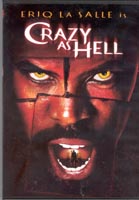
CRAZY AS HELL
2002
Eriq La Salle (director and actor)
BEFORE THE FILM
The film is made by two Julliard students (note references): Eriq(c) La Salle and Michael Beach. La Salle has a B.F.A. in Theater from NYU.
Michael Beach also attended Julliard and went on to acting and appeared in a number of films before making Crazy as Hell.
John C. McGinley (also NYU) co-stars.
Ronny Cox (on three films with LaSalle)
Like Angel Heart, another story with a twist.
Like Angel Heart it is also a “detective story” where the audience needs to see if they can solve the mystery. Where are clues for detectives?
There are many films that do that including Angel Heart, Sixth Sense etc.
Word games people play:
Film Techniques
AFTER THE FILM
In what ways is the film like Angel Heart
How does the film approach the Devil?
How is he introduced (is he really the Devil?). Does Dr. Adams take him seriously as the Devil?
How is the Devil depicted? Male/female variation but not racially or ethnically varied. Does the fact that the actor is African American have an impact on the film? It is a question that is raised with several films like the original Night of the Living Dead.
Steambath has God as a Puerto Rican and of course the new Bedazzled has the Devil as female.
At what point do you begin to suspect he might actually be the Devil?
What is Devil’s relationship to God? How does that relate to Angel Heart?
Taylor – big Ego leads to his downfall – his ego (theories) more important than patient care
Hints to plot:

